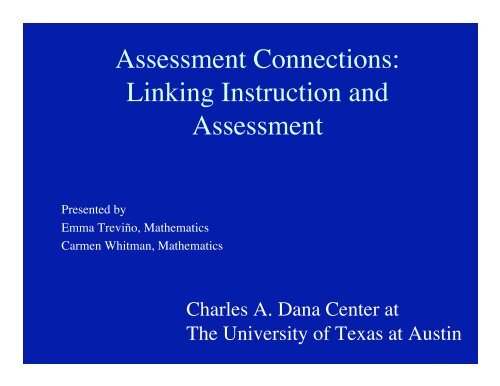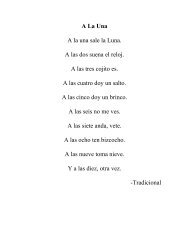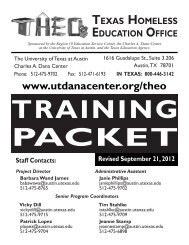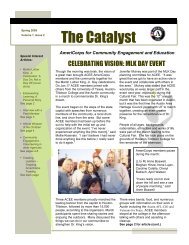Clarifying the TEKS - Charles A. Dana Center
Clarifying the TEKS - Charles A. Dana Center
Clarifying the TEKS - Charles A. Dana Center
You also want an ePaper? Increase the reach of your titles
YUMPU automatically turns print PDFs into web optimized ePapers that Google loves.
Presented by<br />
Assessment Connections:<br />
Linking Instruction and<br />
Emma Treviño, Ma<strong>the</strong>matics<br />
Carmen Whitman, Ma<strong>the</strong>matics<br />
Assessment<br />
<strong>Charles</strong> A. <strong>Dana</strong> <strong>Center</strong> at<br />
The University of Texas at Austin
CAMT 2002
Supports for<br />
<strong>TEKS</strong> and TAKS<br />
CAMT 2002
<strong>Clarifying</strong> Activities<br />
<strong>Clarifying</strong> <strong>the</strong> <strong>TEKS</strong><br />
• What does this student expectation<br />
mean?<br />
• What is an example of something<br />
students would be doing to exhibit this<br />
student expectation?<br />
CAMT 2002
<strong>Clarifying</strong> Activity 6.1 A<br />
The teacher posts an unlabeled, classroom-size<br />
number line marked with <strong>the</strong> benchmarks 0,<br />
1/2, and 1. The teacher provides students with a<br />
variety of non-negative rational numbers<br />
(fractional and decimal form) written on note<br />
cards. Students put <strong>the</strong> note cards in <strong>the</strong><br />
appropriate places on <strong>the</strong> number line.<br />
CAMT 2002
<strong>Clarifying</strong> <strong>the</strong> <strong>TEKS</strong><br />
Assessment Connections<br />
• How can I make this clarifying activity<br />
into an assessment task?<br />
• What do I ask, look for, and listen for<br />
in order to check for student<br />
understanding?<br />
• How does this assessment task link to<br />
TAKS?<br />
CAMT 2002
What would a teacher ask …<br />
To open with?<br />
To probe fur<strong>the</strong>r with?<br />
For what would a teacher listen?<br />
For what would a teacher look?<br />
CAMT 2002
Open with...<br />
Ask...<br />
A general question that will help <strong>the</strong> teacher<br />
determine if <strong>the</strong> student knows <strong>the</strong><br />
ma<strong>the</strong>matics required to solve <strong>the</strong> problem.<br />
CAMT 2002
Probe fur<strong>the</strong>r with…<br />
• Questions designed to help jumpstart<br />
student’s thinking.<br />
• These questions are not in sequential order.<br />
• Teachers may use as many or as few of<br />
<strong>the</strong>se questions as necessary to get students<br />
thinking about <strong>the</strong> ma<strong>the</strong>matics in <strong>the</strong><br />
problem.<br />
CAMT 2002
Listen for...<br />
• What are <strong>the</strong> students talking about?<br />
• What strategies are <strong>the</strong> students using?<br />
• How are students explaining <strong>the</strong>ir<br />
thinking to o<strong>the</strong>rs?<br />
• These questions are to remind <strong>the</strong> teacher<br />
of <strong>the</strong> ma<strong>the</strong>matics <strong>the</strong>y should be<br />
listening for as students are working.<br />
CAMT 2002
Look for...<br />
• What are <strong>the</strong> students doing?<br />
• How are <strong>the</strong>y making sense of <strong>the</strong><br />
problem?<br />
• Are <strong>the</strong>y writing, modeling, recording?<br />
• These questions should be used by <strong>the</strong><br />
teacher to help her understand what <strong>the</strong><br />
students are doing.<br />
CAMT 2002
***<br />
But what about TAKS?<br />
***<br />
CAMT 2002
***<br />
All assessment connections give<br />
an example of a<br />
TAKS<br />
like problem<br />
***<br />
CAMT 2002
6.1A TAKS Connection<br />
CAMT 2002
<strong>Clarifying</strong> <strong>the</strong> <strong>TEKS</strong><br />
<strong>Clarifying</strong> Lessons and Assessments<br />
• How do I, as a teacher, teach this?<br />
• What does a lesson look like that<br />
addresses this knowledge and skill or<br />
student expectation?<br />
• How can I assess this?<br />
• How can this part of <strong>the</strong> <strong>TEKS</strong> be<br />
connected to o<strong>the</strong>r parts of <strong>the</strong> <strong>TEKS</strong>?<br />
CAMT 2002
<strong>Clarifying</strong> Lesson Grade 7:<br />
More Land or Water?<br />
Divide and Conquer<br />
• <strong>TEKS</strong> Strands: Number Operations and<br />
Quantitative Reasoning, Patterns Relationships<br />
and Algebraic thinking,Underlying Processes and<br />
Ma<strong>the</strong>matical Tools<br />
• Lesson Resources<br />
• Materials<br />
• Set-Up<br />
CAMT 2002
<strong>Clarifying</strong> Lesson Grade 7:<br />
Divide and Conquer<br />
• Guiding Questions (to engage students in ma<strong>the</strong>matical<br />
thinking during <strong>the</strong> lesson)<br />
• Summary Questions (to direct students’ attention to <strong>the</strong><br />
key ma<strong>the</strong>matics in <strong>the</strong> lesson)<br />
• Assessment Tasks (to identify <strong>the</strong> ma<strong>the</strong>matics students<br />
have learned in <strong>the</strong> lesson)<br />
• Extensions (to lead students to connect <strong>the</strong> ma<strong>the</strong>matics<br />
learned to o<strong>the</strong>r situations, both within and outside <strong>the</strong><br />
classroom)<br />
CAMT 2002
<strong>Clarifying</strong> Lesson Grade 7:<br />
Lesson Overview<br />
Given problems involving whole numbers, students will analyze responses<br />
to two different types of division problems and discuss how <strong>the</strong> inclusion of<br />
<strong>the</strong> language of sharing and grouping will help students recognize situations<br />
that require division. Students will solve a sequence of problems organized<br />
to provide scaffolding for understanding of an algorithm for division of<br />
fractions. Emphasis will be placed on using pictures or diagrams and<br />
written descriptions of <strong>the</strong> thought processes involved to support problems<br />
solutions and development of an algorithm.<br />
Ma<strong>the</strong>matics Overview<br />
Students will build a conceptual understanding of <strong>the</strong> division<br />
of fractions through division of whole numbers and modeling<br />
of division of fractional parts.<br />
CAMT 2002
Where do I find <strong>the</strong><br />
<strong>Clarifying</strong> Lessons,<br />
Assessment Connections, and<br />
<strong>Clarifying</strong> Lessons<br />
CAMT 2002
All of <strong>the</strong>se can be downloaded<br />
from our website at<br />
www.mathtekstoolkit.org<br />
CAMT 2002
CAMT 2002
CAMT 2002
CAMT 2002
Ma<strong>the</strong>matics <strong>TEKS</strong> Toolkit<br />
www.tenet.edu/teks/math<br />
or<br />
www.mathtekstoolkit.org<br />
Texas Essential Knowledge and Skills<br />
(<strong>TEKS</strong>)<br />
Supporting <strong>the</strong> <strong>TEKS</strong> and TAKS<br />
Instruction and Assessment<br />
Professional Development<br />
Resources<br />
Program Development: Quality Math for All<br />
CAMT 2002








